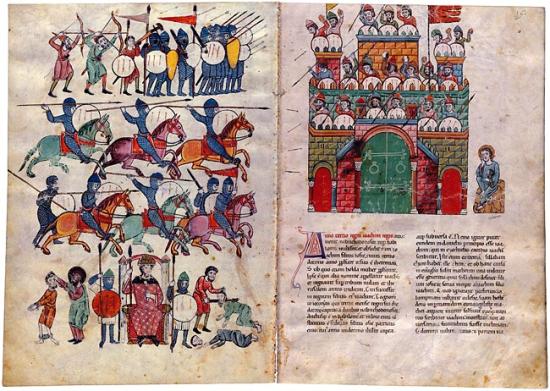
Siege of Jerusalem
Beatus of Liébana
Las Huelgas Apocalypse
Purchased by Pierpont Morgan, 1910
In the third year of the reign of Jehoiakim king of Judah, Nebuchadnezzar king of Babylon came to Jerusalem and besieged it. (Dan. 1:1)
This miniature actually illustrates an earlier siege in which Nebuchadnezzar captured Jerusalem and, on the plain of Jericho, the escaping King Sedecias of Judah. At the bottom left sits the enthroned Nebuchadnezzar, flanked by guards in thirteenth-century armor; he directs the blinding of Sedecias and the killing of his sons (4 Kings 25:1–7). On the opposite page, Jeremiah, seated outside the city, laments the fall of Jerusalem and defeat of the Israelites.
The Apocalypse, or Book of Revelation, is not only the last Book of the New Testament, but its most difficult, puzzling, and terrifying. It provided challenges to medieval illustrators and was the source for a number of popular images, such as Christ in Majesty, the Adoration of the Lamb, and the Madonna of the Apocalypse and contributed to the widespread use of the Evangelists' symbols.
Selected images from Apocalypse Then: Medieval Illuminations from the Morgan, an exhibition held at the Morgan are presented here. The exhibition celebrates the completion of a facsimile of the Morgan's Las Huelgas Apocalypse—the latest dated (1220) and largest surviving manuscript of a Spanish tradition of illuminated commentaries on the Apocalypse by the monk Beatus of Liébana. The series of manuscripts constitutes Spain's most important contribution to medieval manuscript illumination.
The Las Huelgas Apocalypse contains three sections: the prefatory cycle, the Apocalypse, and the Book of Daniel.
In addition to forty-nine images from the Las Huelgas Apocalypse, six images from other manuscripts in the Morgan's collections, including the earliest Beatus painted by Maius and one by the Master of the Berry Apocalypse, are in this presentation.
